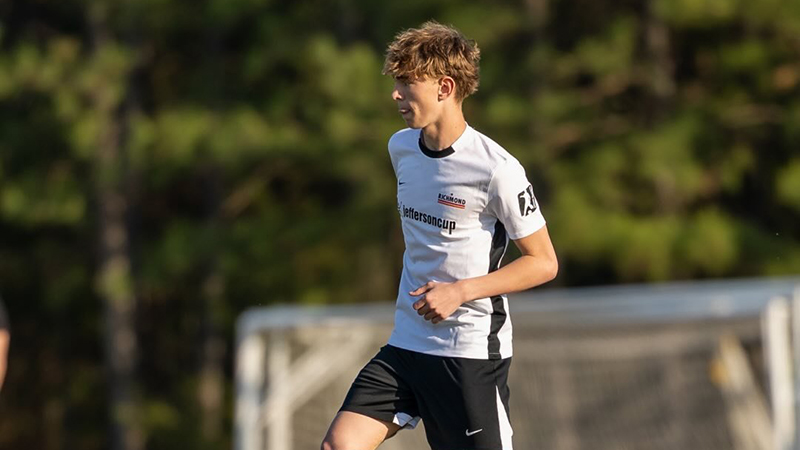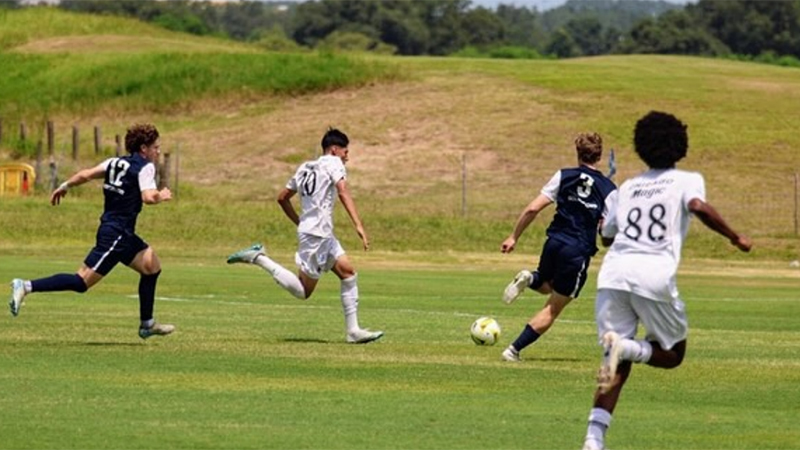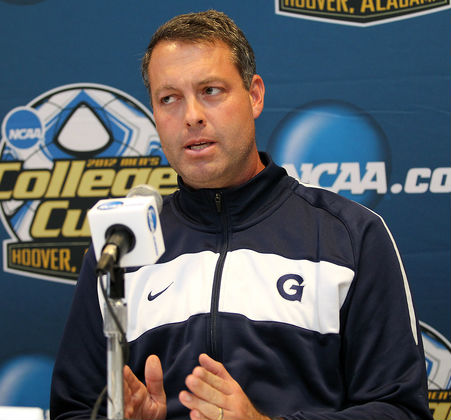 Brian Wiese at the 2012 College Cup
Brian Wiese at the 2012 College CupThe rise of Georgetown men's soccer
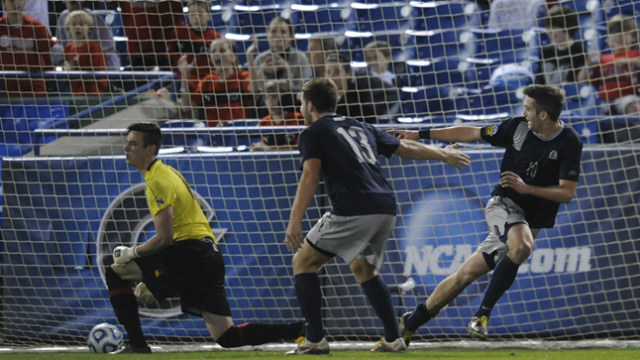
“Can we get it done here?”
Georgetown athletic director Bernard Muir stares across his McDonough Arena desk at the interviewee.
 Brian Wiese at the 2012 College Cup
Brian Wiese at the 2012 College CupIt’s February of 2006, and following the retirement of 22-year boss Keith Tabatznik, the university’s men’s soccer head coaching position is open. Muir’s question is equally so.
And Notre Dame assistant coach Brian Wiese doesn’t hesitate with his response.
“I don’t see why not,” Wiese tells Muir simply.
The job is his.
Given the state of the program at the time — for the most part mired in Big East mediocrity — Wiese’s bravado that day in Muir’s office might have seemed foolish.
But after a 2012 national runner-up finish in just the program’s fourth-ever NCAA tournament appearance, it now appears almost shockingly prophetic.
GROWING PAINS
As Washington Post Soccer Insider Steven Goff explained, his job for the Post is essentially to cover DMV soccer wherever there’s a compelling story to be told. But up until 2010, there hadn’t been one on the Hilltop.
“I’d kept an eye on [Georgetown] over the years, but they’d never been good enough to follow regularly,” Goff said. “I don’t follow a lot of college soccer as it is, so a local team has to go a long way or go high up in the national rankings to attract media attention.”
For years, then, the limited amount of college soccer talk that went on in the District centered around Maryland, Virginia, and even Virginia Tech during its 2007 College Cup run. Georgetown, meanwhile, remained off the media grid.
A large factor in the Hoyas’ struggles prior to 2010 was the program’s historic dearth of scholarships. Tabatznik — who was in charge before Wiese from 1984 to 2005 — had none to give out for the first 10 years of his tenure, and by the time he resigned, he had only two.
Unsurprisingly, that incredibly small number restricted a lot of what Tabatznik was able to do.
“It was a different set-up in a way, that it was maybe harder for him to get some of those kids that were at that level,” Wiese said.
In spite of the men’s soccer team’s serious financial constraints, though, Georgetown was certainly not without its moments in the Tabatznik era.
In 1994, the American University graduate guided his local rival to its first-ever Big East regular season title as well as its first NCAA tournament berth. Three years later, Tabatznik made sure that the Hoyas weren’t one and done in their second trip to the tourney, as a 2-1 win over VCU secured the program’s inaugural NCAA tournament victory.
Another, however, wouldn’t come for over a decade.
Enter Wiese.
Given the state of the program when he took over in 2006, the fit couldn’t have been more perfect on paper, and not just because of the new hire’s background in the Beautiful Game. The former Dartmouth captain and goalkeeper earned an undergraduate degree in mechanical engineering and later, in the midst of his coaching duties at the university, got his master’s from Stanford in 1998.
The task that lay ahead of Wiese may have been more one of genetic engineering than mechanical, but the New Mexico native was supremely confident in his ability to put the pieces together. And he wasn't alone.
"Oftentimes, the key to a coach being successful is if he/she is an institutional fit,” said current Georgetown A.D. Lee Reed. “And Brian [was] definitely that.”
‘WE JUST WERE MISSING SOMETHING’
In truth, Wiese wanted to complete the puzzle sooner rather than later, his heart set on mimicking the immediate turnaround at Notre Dame that was pulled off by Bobby Clarke, his old boss in both South Bend and Palo Alto.
It wouldn’t happen.
The Hoyas finished just 3-8 in conference play and 6-11 overall in Wiese’s first year. Having failed to qualify for the Big East tournament, the team’s highlight was a telling one: an overtime win over lowly 1-15 Marquette in its season finale at North Kehoe Field.
Standout forward Ricky Schramm (MSB ’07) would be drafted in the third round by local Major League Soccer club D.C. United after the season, but the predominant mentality of the team that remained was hardly professional.
The blueprint going forward, in Wiese’s eyes, was clear: Bring in student-athletes with higher aspirations and good technical ability, and let them go. The cultural shift he sought, of course, was not something that was going to come easily.
“We weren’t bad, it wasn’t a bad side — we just were missing something to win some of these games,” Wiese said. “If you have 25 players and 20 of them are trained to think a certain way and five [freshmen] are just coming into that environment, it’s very hard [to change things].”
And although it would take a full four-year cycle for Wiese’s vision to be truly realized, ripples of change started to appear in his third season with the Blue and Gray.
In 2008, the team finished 12-5-3 (Wiese’s best record by a full five games), and, while they once again didn’t qualify for the NCAA tournament, the Hoyas did win a game in the conference tourney for the first time under their new coach.
Junior forward Steve Neumann, a Hermann Trophy semifinalist in 2012, was in high school in 2008 and right in the middle of his recruiting process. Georgetown’s improvement that year didn’t go unnoticed.
“I looked at it as a little bit of a program on the rise,” Neumann said. “Wiese was fairly new as a head coach and was taking the right kinds of steps to boost the program in the right direction.”
Then, in 2009 — the season before Neumann arrived at Georgetown — the table would finally be set.
THE REVOLUTIONARIES
As Brian Wiese entered his fourth season at the Georgetown helm, out went another Tabatznik class, and in came a quartet that would change the course of the program’s history: barely recruited winger Andy Riemer, from right down the road in McLean, Va., Iowan central midfielder Ian Christianson, center back and Florida native Tommy Muller, attacking left back Jimmy Nealis of Long Island.
All four would go on to be drafted by MLS this past winter, and all four were gunning for that goal from the day they arrived in the District.
“They saw the sort of building blocks, but they still had this internal [mentality] of, ‘Well, we’re going to be pros.’ There was no questioning, and they reinforced each other that way,” Wiese said. “They were this little pod that kind of, amongst all the distractions and potential diversions, they [thought], ‘Everything we do is about winning and about being better soccer players.”
The group’s first season didn’t live up to its lofty expectations, as Georgetown bowed out of the Big East tournament to DePaul on penalty kicks at North Kehoe.
The pros-to-be found themselves wanting more. And, as it turned out, they wouldn’t have to wait long: The next season, after a 13-year gap, the Georgetown men’s soccer team returned to the promised land of the NCAA tournament.
While a hungry quartet of sophomores and a couple of precocious freshmen played substantial parts in getting their team to the second round, the run was largely driven by Wiese’s first recruiting class at Georgetown — by 2010, it was all grown up.
“The senior class, my freshman year, was a bunch of guys that Wiese recruited,” Neumann, the team’s super-sub that season, said.
After four years, as the Pennsylvanian put it, Georgetown had an upperclassman group of “solid players that were kind of starting to move the program in the right direction.”
The path to success had been at least partially blazed, then, and though 2011 would not serve as an adequate follow-up, those still-developing sophomores of 2010 entered 2012 as hardened and determined seniors.
‘WE CAN BEAT ANYONE’
Historically, it wasn’t a common thought.
As a program with just three NCAA tournament appearances under its belt since its inception in 1950, Georgetown men’s soccer typically was, as the cliché goes, just happy to be there. The Class of 2012 would prove an exception.
And, as the season progressed, merely winning a couple games upon getting ‘there’ proved equally insufficient. Tommy Muller and his classmates weren’t going to settle.
“I remember talking to Ian [Christianson] the summer before our senior year, and we were just saying, ‘Let’s go win a national championship. Let’s go out on top, like let’s do it,’” Muller, now with the San Jose Earthquakes, said. “We said it to each other kind of casually, but as the season went on and we were in the top 10, top five, we were like, ‘Wow, we could actually win this.’
“That’d always been a goal, that’d always been the dream, but I think it was in the preseason when we started to train and things looked really good, we kind of all looked at each other and said, ‘We can beat anyone.”
Unranked to start the 2012 season, Georgetown entered the top 25 after a season-opening victory over Virginia, a program with six national titles to its credit.
And the wins just kept on coming from there, to the point where — after a blistering 10-0-1 start — the greater Washington media had no choice but to take notice.
As Goff put it, “They earned the coverage.”
Out of nowhere and really for the first time, Georgetown soccer had made itself relevant in 2012. And it more than lived up to its place in the spotlight, losing just two games over the course of the entire regular season and finishing in a four-way tie for the No. 1 seed in the Big East tournament.
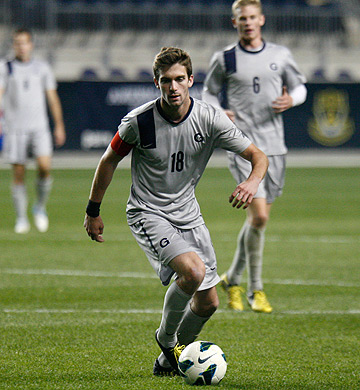 Neumann in action last fall
Neumann in action last fallWhere it would all fall apart, though, was in the Big East final at the Philadelphia Union’s PPL Park, as a lead over Notre Dame with under a minute to go slipped agonizingly away. It would have been the first tournament title in program history, but a devastated Wiese and Co. picked their heads up and carried on.
And on. And on.
A PERCEPTION CHANGED
Seeded atop its region for the NCAA tournament, the Hoyas were, in theory, ‘supposed’ to make it through to the College Cup in Hoover, Ala. And, even without much experience to draw from, they played like it, mounting second-half comebacks against both Big East foe Syracuse in the Sweet 16 and San Diego in the Elite Eight.
The latter game was a surprise, but not for what transpired on the pitch — North Kehoe Field, for the first time in recent memory, was standing room only.
“It was incredible, the amount of support we got [against San Diego] from the student body, from alums,” Muller said. “We never really expected a big crowd at home games — that was kind of just the norm.”
If the past five months are any indication, it’s not the norm anymore.
Georgetown escaped local foe Maryland in the Final Four, and Indiana was up after that in the national championship. Reed would organize a road trip to Alabama for the title game, and it didn’t take long to run out of seats.
“We filled out the road trip in like an hour,” former Hoya Blue communications director Sam Kareff (SFS ’13) said. “It was really just an hour. It was awesome.”
The fans who embarked on that 26-hour round trip may not have witnessed their team get the chance to raise the trophy — the Hoyas would be shut out for just the second time all season in a 1-0 heartbreaker — but what they were witnesses to was the completion of their program’s rise.
In the months after that title game, Hoya Blue saw its membership experience a dramatic spike, and a spring friendly against William & Mary brought in more fans to North Kehoe than early regular season games even had in 2012.
Investment in the men’s soccer program is at an undeniable all-time high.
“When I walk around campus, [students now] want to talk to you about it, and they start having a familiarity with what the team is,” Wiese said. “That happens all over the place — they want to talk about the team.”
“Everyone’s really interested in [the team] now, even MLS stuff,” Kareff added. “That would have never happened three years ago.”
STAYING POWER
But the 2012 team’s impact extends far beyond merely putting people in the stands or those passing conversations in the quad.
“In the past, it was harder for Georgetown. Because there weren’t soccer scholarships, the academic demands were so high that they’d lose out on a lot of guys, and most of the best players would end up in the ACC,” Goff said. “But with the quality of the school that [Wiese] has to offer and the rise of the program, he’s been able to get these players who are of international caliber.”
Two such players would be freshman striker Allen, who featured in World Cup Qualifiers this spring for the United States U20 Men’s National Team, and sophomore goalkeeper Tomas Gomez, who played a bit for the U20 MNT last year as well. Both will surely get looks from MLS, following in the footsteps of Muller, Christianson, winger Andy Riemer and left back Jimmy Nealis, all of whom fulfilled their goals of being drafted by the league following this past season.
And while Wiese disclosed that his entire highly-rated 2013 recruiting class — which includes standouts like Joshua Yaro, Alex Muyl and Brett Campbell — had been signed before last fall, the above success stories are sure to bring even more talent farther along the line. Look no further than the example of U17 men's national team midfielder Christopher Lema, who committed to the program just this week.
Having nowhere near the same kind of exposure as college basketball, football or even baseball, college soccer programs largely rely on short-term memory when it comes to recruiting. Such was evident in an interview with one prospective sophomore recruit, who asked to remain anonymous, when he at one point mentioned how “Georgetown is really good at soccer.”
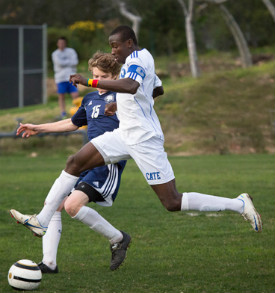 Georgetown recruit Joshua Yaro
Georgetown recruit Joshua YaroThat sound you just heard? That was the whoosh of a half-century’s worth of Hoya history being thrown right out the window. As far as college soccer is concerned, perhaps one year does, in fact, a program make.
Or, at least, so some are hoping.
“What if we became a soccer school?” pondered a reflective Kareff, echoing Wiese’s comments at the team’s College Cup welcome-back rally. “That would completely transform everyone’s undergrad experience and make it completely different. But it’s a cool thing to think about.”
For many hardwood diehards on the Hilltop, it might also appear an absurd thing to think about. A short time ago, however, it would have been considerably more so.
Before 2012, just five players all time had been drafted out of Georgetown by Major League Soccer, none had become stars and only Dan Gargan (MSB ’05) was still on an active roster.
The stands had been empty. The fans apathetic. The College Cup a pipe dream.
Then, somehow, over the course of just 26 wild games, everything changed. And from behind his crystal ball when he first took the job that fateful day in 2006, the architect of Georgetown’s great leap forward had foretold it all.
“[Muir] never said what ‘it’ meant, what ‘it’ was, and I never defined that for him,” Wiese said. “But I said, ‘I don’t see why not.’ Why not?”
Whatever ‘it’ may actually have been, Wiese definitely did get it done in 2012. Muir’s definition doesn’t matter anymore.
The only question now is where Georgetown can go from here.
Ryan Bacic is a sophomore history major at Georgetown and the Sports Editor of The Hoya, where an earlier version of this story ran in two parts on April 19 and 26. He can be reached via email at bacicryan@gmail.com or on Twitter @BackToBacics.
Headlines
- Recruiting Roundup: December 22-January 4
- 2026 Women's Division I Transfer Tracker
- ECNL Boys FL Selection Game Rosters
- TDS Boys Regional Rankings: Class of 2028
- 25 Male Players That Dominated 2025
-
ECNL Boys Florida: U17 Players to Know

- 25 Female Players That Dominated 2025
-
Women's DI Recruiting Ranks: Dec.

-
ECNL Boys FL: Under-19 Players to Know

-
Commitments: NEPSAC Star Heads West


